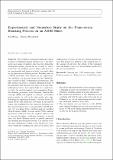Experimental and numerical study on the plane-strain blanking process on an AHSS sheet
Author(s)
Wang, Kai; Wierzbicki, Tomasz
Download10704_2015_34_ReferencePDF.pdf (9.034Mb)
OPEN_ACCESS_POLICY
Open Access Policy
Creative Commons Attribution-Noncommercial-Share Alike
Terms of use
Metadata
Show full item recordAbstract
The blanking/trimming/cropping process introduces a substantial plastic deformation to the sheet metal and causes premature edge fracture during the subsequent forming process. In an attempt to understand how the blanking process affects edge fracture, an experimental and numerical study was undertaken on the plane-strain blanking process. Blanking tests on a DP780 steel sheet were carried out on a special fixture utilizing a in-situ microscope for the digital mage correlation (DIC) deformation measurement. The DIC method provides a detailed deformation field of the specimen that has not been reported in any other publications before. Interrupted tests were carried out to study the crack formation and propagation during the blanking procedure, while scanning electron microscope was applied to examine the blanked surface quality as well as the edge profile after test. Following the experimental study, a detailed finite element model with mesh size of 0.01 mm in the critical region was established for the numerical investigation. The model features (a) a non-associated Hill 48 flow rule, (b) von-Mises yield condition and (c) modified Mohr–Coulomb fracture model. With material parameters calibrated from the in-plane tests as well as accurate boundary conditions measured in actual tests, the finite element model accurately predicted the blanking process quantitatively. The current study also gave quantitative values of the parameters of interest during the blanking test, such as the global load displacement response and the local strain gradient history. The geometrical features of the blanked edge, i.e. the amount of roll over, the extent of the burnished zone and fracture zone were all accurately predicted by the present simulation.
Date issued
2015-07Department
Massachusetts Institute of Technology. Department of Mechanical Engineering; Massachusetts Institute of Technology. Impact and Crashworthiness LaboratoryJournal
International Journal of Fracture
Publisher
Springer Netherlands
Citation
Wang, Kai, and Tomasz Wierzbicki. “Experimental and Numerical Study on the Plane-Strain Blanking Process on an AHSS Sheet.” International Journal of Fracture 194, no. 1 (July 2015): 19–36.
Version: Author's final manuscript
ISSN
0376-9429
1573-2673